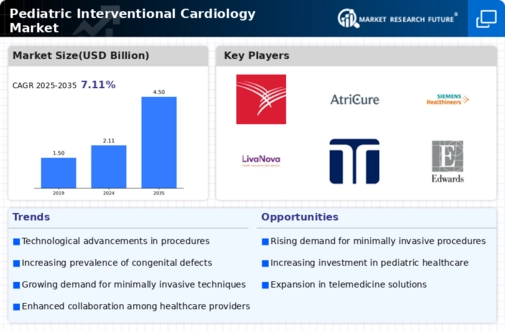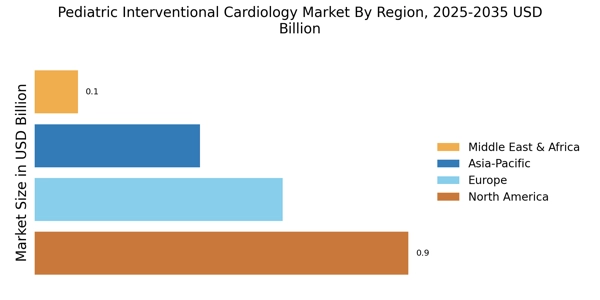Increased Awareness and Screening
Rising awareness regarding congenital heart defects and the importance of early detection is driving the Pediatric Interventional Cardiology Market. Educational campaigns and initiatives by healthcare organizations have led to improved screening practices, enabling earlier diagnosis and intervention. Data indicates that early intervention can significantly enhance long-term outcomes for pediatric patients. As a result, there is a growing demand for interventional cardiology services, which is reflected in the increasing number of procedures performed annually. This heightened awareness is likely to continue influencing the market positively, as more parents and healthcare providers recognize the critical role of timely intervention in managing pediatric cardiac conditions.
Growing Incidence of Congenital Heart Defects
The rising incidence of congenital heart defects (CHDs) is a significant driver of the Pediatric Interventional Cardiology Market. Statistics indicate that approximately 1 in 100 children are born with a congenital heart defect, necessitating timely and effective intervention. This increasing prevalence is prompting healthcare systems to enhance their capabilities in pediatric cardiology, leading to a higher demand for interventional procedures. As awareness of CHDs grows, so does the urgency for innovative treatment solutions. The market is expected to expand as healthcare providers seek to address this pressing need, ensuring that children with cardiac conditions receive the specialized care they require.
Regulatory Support and Reimbursement Policies
Supportive regulatory frameworks and favorable reimbursement policies are playing a crucial role in the Pediatric Interventional Cardiology Market. Governments and health authorities are increasingly recognizing the need for specialized pediatric care, leading to the establishment of guidelines that facilitate the approval of new devices and procedures. Additionally, improved reimbursement rates for pediatric cardiac interventions are encouraging healthcare providers to adopt innovative treatment options. This regulatory support is essential for fostering an environment conducive to market growth, as it not only enhances access to care but also incentivizes the development of new technologies. As reimbursement policies continue to evolve, they are likely to further stimulate investment in pediatric interventional cardiology.
Collaborative Efforts in Research and Development
The Pediatric Interventional Cardiology Market is benefiting from collaborative efforts among various stakeholders, including hospitals, research institutions, and medical device manufacturers. These partnerships are fostering innovation and accelerating the development of new therapies and devices tailored for pediatric patients. Recent studies have shown that collaborative research initiatives can lead to breakthroughs in treatment methodologies, enhancing the overall quality of care. Furthermore, funding from governmental and non-governmental organizations is increasingly directed towards pediatric cardiology research, which is expected to yield new insights and technologies. This collaborative environment is likely to drive market growth as new solutions emerge to address the unique challenges faced in treating pediatric cardiac conditions.
Technological Advancements in Pediatric Interventional Cardiology
The Pediatric Interventional Cardiology Market is experiencing a surge in technological advancements that enhance the precision and efficacy of cardiac procedures. Innovations such as 3D imaging, minimally invasive techniques, and advanced catheter technologies are transforming treatment protocols. For instance, the introduction of hybrid operating rooms allows for simultaneous imaging and intervention, significantly improving patient outcomes. According to recent data, the market for pediatric cardiac devices is projected to grow at a compound annual growth rate of approximately 8% over the next five years. This growth is largely attributed to the increasing adoption of these advanced technologies, which not only reduce recovery times but also minimize the risks associated with traditional surgical methods.


















Leave a Comment